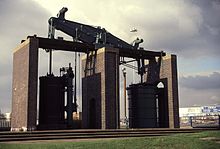
James Watt was a Scottish inventor, mechanical engineer, and chemist who improved on Thomas Newcomen's 1712 Newcomen steam engine with his Watt steam engine in 1776, which was fundamental to the changes brought by the Industrial Revolution in both his native country Great Britain, and the rest of the world.

William Murdoch was a Scottish chemist, inventor, and mechanical engineer.

Thomas Newcomen was an English inventor who created the atmospheric engine, the first practical fuel-burning engine in 1712. He was an ironmonger by trade and a Baptist lay preacher by calling.

The Watt steam engine design became synonymous with steam engines, and it was many years before significantly new designs began to replace the basic Watt design.

Matthew Boulton was an English businessman, inventor, mechanical engineer, and silversmith. He was a business partner of the Scottish engineer James Watt. In the final quarter of the 18th century, the partnership installed hundreds of Boulton & Watt steam engines, which were a great advance on the state of the art, making possible the mechanisation of factories and mills. Boulton applied modern techniques to the minting of coins, striking millions of pieces for Britain and other countries, and supplying the Royal Mint with up-to-date equipment.
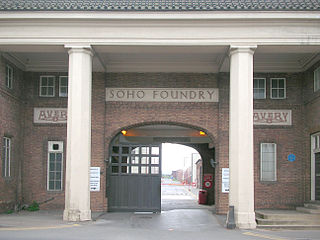
Soho Foundry is a factory created in 1775 by Matthew Boulton and James Watt and their sons Matthew Robinson Boulton and James Watt Jr. at Smethwick, West Midlands, England, for the manufacture of steam engines. Now owned by Avery Weigh-Tronix, it is used for the manufacture of weighing machines.
The year 1779 in science and technology involved some significant events.

The Smethwick Engine is a Watt steam engine made by Boulton and Watt, which was installed near Birmingham, England, and was brought into service in May 1779. Now at Thinktank, Birmingham Science Museum, it is the oldest working steam engine and the oldest working engine in the world.
Steam power developed slowly over a period of several hundred years, progressing through expensive and fairly limited devices in the early 17th century, to useful pumps for mining in 1700, and then to Watt's improved steam engine designs in the late 18th century. It is these later designs, introduced just when the need for practical power was growing due to the Industrial Revolution, that truly made steam power commonplace.
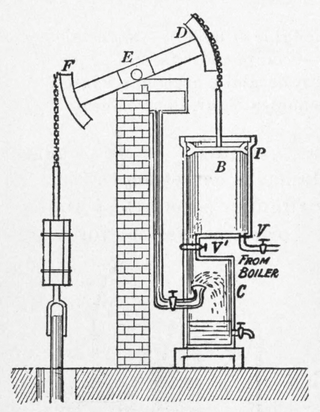
A beam engine is a type of steam engine where a pivoted overhead beam is used to apply the force from a vertical piston to a vertical connecting rod. This configuration, with the engine directly driving a pump, was first used by Thomas Newcomen around 1705 to remove water from mines in Cornwall. The efficiency of the engines was improved by engineers including James Watt, who added a separate condenser; Jonathan Hornblower and Arthur Woolf, who compounded the cylinders; and William McNaught, who devised a method of compounding an existing engine. Beam engines were first used to pump water out of mines or into canals but could be used to pump water to supplement the flow for a waterwheel powering a mill.
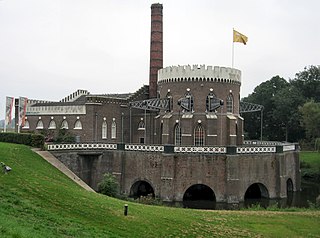
A Cornish engine is a type of steam engine developed in Cornwall, England, mainly for pumping water from a mine. It is a form of beam engine that uses steam at a higher pressure than the earlier engines designed by James Watt. The engines were also used for powering man engines to assist the underground miners' journeys to and from their working levels, for winching materials into and out of the mine, and for powering on-site ore stamping machinery.
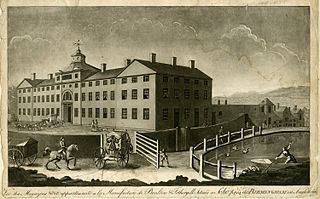
Soho Mint was created by Matthew Boulton in 1788 in his Soho Manufactory in Handsworth, West Midlands, England. A mint was erected at the manufactory containing eight machines, to his own patent design, driven by steam engine, each capable of striking 70 to 85 coins per minute.

The Engine Arm or Birmingham Feeder Arm near Smethwick, West Midlands, England, is a short canal which was originally part of a feeder tunnel for a pumping engine. When the Smethwick flight of locks were reduced from six to three, the pumping engine was moved to a new site, which allowed part of the feeder tunnel to be opened up and made navigable, so that coal supplies for the engine could be delivered by barge. The Engine Arm also supplied the pumped water to the 473-foot (144 m) Wolverhampton level of the lowered summit. The arm was extended between 1825 and 1830 by Thomas Telford to carry water from Rotton Park Reservoir to the Old Main Line of the BCN Main Line Canal, and the Engine Arm Aqueduct was inserted to carry it over the new main line constructed at that time, which was 20 feet (6.1 m) lower. The arm is now managed by the Canal and River Trust and the basin beyond the site of the pumping station, which was replaced by a new engine house near Brasshouse Lane bridge in 1892, is used for residential moorings.

The first recorded rudimentary steam engine was the aeolipile mentioned by Vitruvius between 30 and 15 BC and, described by Heron of Alexandria in 1st-century Roman Egypt. Several steam-powered devices were later experimented with or proposed, such as Taqi al-Din's steam jack, a steam turbine in 16th-century Ottoman Egypt, and Thomas Savery's steam pump in 17th-century England. In 1712, Thomas Newcomen's atmospheric engine became the first commercially successful engine using the principle of the piston and cylinder, which was the fundamental type of steam engine used until the early 20th century. The steam engine was used to pump water out of coal mines.
Shudehill Mill or Simpson's Mill was a very early cotton mill in Manchester city centre, England. It was built in 1782 by for Richard Arkwright and his partners and destroyed by fire in 1854. It was rebuilt and finally destroyed during the Manchester Blitz in 1940. One of Arkwright's larger mills, it was built three years before his patent lapsed. The mill had a 30 feet diameter water wheel and a Newcomen atmospheric engine was installed. Doubts remain as to why the engine was installed, whether it was a failed attempt to power a mill directly by steam or was modified to assist the wheel. It is possible that this engine, constructed by Hunt, could have been one of the 13 engines installed in Manchester mills by Joshua Wrigley. Water from the upper storage pond turned the water wheel to drive the mill. The steam engine recycled water from the lower storage pond to the upper storage pond. Three more Boulton and Watt engines were installed to power the increasing number of spindles.

Old Bess is an early beam engine built by the partnership of Boulton and Watt. The engine was constructed in 1777 and worked until 1848.
A water-returning engine was an early form of stationary steam engine, developed at the start of the Industrial Revolution in the middle of the 18th century. The first beam engines did not generate power by rotating a shaft but were developed as water pumps, mostly for draining mines. By coupling this pump with a water wheel, they could be used to drive machinery.
Resolution was an early beam engine, installed between 1781 and 1782 at Coalbrookdale as a water-returning engine to power the blast furnaces and ironworks there. It was one of the last water-returning engines to be constructed, before the rotative beam engine made this type of engine obsolete.

The Newcomen Memorial Engine is a preserved beam engine in Dartmouth, Devon. It was preserved as a memorial to Thomas Newcomen, inventor of the beam engine, who was born in Dartmouth.

The Lap Engine is a beam engine designed by James Watt, built by Boulton and Watt in 1788. It is now preserved at the Science Museum, London.

